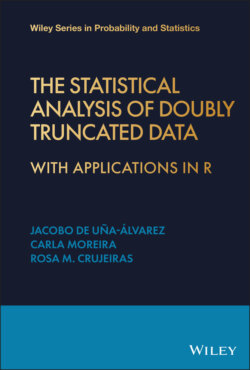Читать книгу The Statistical Analysis of Doubly Truncated Data - Prof Jacobo de Uña-Álvarez, Prof Carla Moreira - Страница 21
1.4.4 Quasar Data
ОглавлениеA classical motivating example of doubly truncated data, introduced by Efron and Petrosian (1999), is found in cosmology when registering the luminosity of quasars. Quasars are observed only if the luminosity lies within a certain interval, bounded at both ends that are determined by detection limits of observation devices, so the data suffer from double truncation. The original dataset studied by Efron and Petrosian (1999) comprises triplets , where is the luminosity in the log‐scale, obtained from a transformation model based on the redshift and the apparent magnitude of the th quasar. See Efron and Petrosian (1999) for further details on the transformation model. Due to experimental constraints, the distribution of each luminosity in the log‐scale is truncated to a known interval . Specifically, quasars with apparent magnitude above were too dim to yield dependent redshifts, and hence they were excluded from the study. In addition, the lower limit was used to avoid confusion with non‐quasar stellar objects. Some descriptive statistics are provided in Table 1.4.
Table 1.3 Years to failure and number of failing units for the Equipment‐ S Rounded Failure Time Data.
| Years: | 0–4 | 5–9 | 10–14 | 15–19 | 20–24 | 25–29 | 30–34 |
|---|---|---|---|---|---|---|---|
| N. units: | 1 | 26 | 26 | 51 | 44 | 14 | 12 |
Table 1.4 Descriptive statistics for the Quasar Data. Luminosity in log‐scale () and observation interval .
| Variable | Min | Q1 | Q2 | Mean | Q3 | Max |
|---|---|---|---|---|---|---|
| X | 0.39 | 0.24 | 0.71 | 2.08 | ||
| U | 0.26 | 0.75 | ||||
| V | 0.15 | 1.78 | 2.10 | 1.95 | 2.36 | 2.58 |
The Quasar Data are used in Chapter 3. This classical example is also included in the DTDA package (dataset Quasars).
